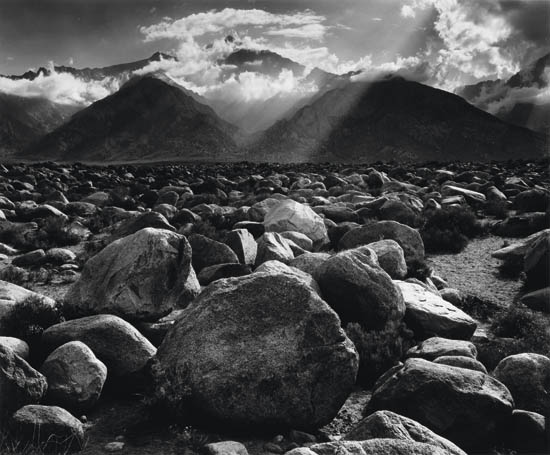Sale 2208 - Lot 179
Unsold
Estimate: $ 20,000 - $ 30,000
ADAMS, ANSEL (1902-1984)
"Mount Williamson, Sierra Nevada, From Manzanar, California." Silver print, 15 1/4x18 1/2 inches (38.7x47 cm.), on a Crescent board mount, with Adams's signature, in ink, on mount recto and his early Carmel hand stamp with the title and negative number, in ink, in an unknown hand, on mount verso. 1944; printed late 1960s
"Mount Williamson, Sierra Nevada, From Manzanar, California." Silver print, 15 1/4x18 1/2 inches (38.7x47 cm.), on a Crescent board mount, with Adams's signature, in ink, on mount recto and his early Carmel hand stamp with the title and negative number, in ink, in an unknown hand, on mount verso. 1944; printed late 1960s
Additional Details
From the collection of Elsa Leightner, to John Boland.
Ansel Adams: 400 Photographs, 261.
Ansel Adams made some of his best photographs of 1943-1945 within and close to Manzanar, which was set in a desolate desert surrounded by mountain ranges he knew intimately and had spent decades photographing. This majestic view has all the hallmarks of an Adams landscape: the Sierra Mountains shows peaks rising more than eleven thousand feet above the desert floor are captured with a remarkable exactidue, from the detailed rocky foreground to the snow-capped mountain tops.
Manzanar is also widely known as the site where more than 110,000 Japanese Americans were imprisoned during World War II. Adams had driven by the camp many times but was invited by its director, Ralph Merritt, to visit. He noted that Japanese-Americans, who have a deep reverence for nature, were inspired and strengthened by the setting, which gave them "a certain respite from their mood of isolation and concern for the future." He was impressed by the efforts of the detainees to make the camp more livable and functional by creating a Japanese garden, farms, schools, churches (Buddhist, Christian, and Shinto), a playground, and small industries. Detainees, with permission and under guard, could "gather stones and plants for the Japanese garden they constructed." Soon after Adams created an important body of work that addressed the hardships endured by Japanese Americans,entitled Born Free and Equal: Photographs of the Loyal Japanese-Americans at the Manzanar Relocation Center, Inyo County, California (New York: U.S. Camera, 1944).
At first glance the picture seems grand, reflecting Adams's love for the natural environment. But, on second glance it also serves as a metaphor for the site where Japanese-Americans were forcibly removed from their homes and evacuated to a relocation camp where they lived as prisoners, deprived of any rights and freedom. For, Adams's depicts a rugged and dramatic environment, one in which "something" is about to happen. The stormy clouds, dramatic light, and imposing rocks impart a foreboding quality to the scene.
Adams, always the consummate technician, addressed the importance of finding the right light: "It is difficult to photograph on the ordinary bright, clear desert days, as the value of the rock may blend with that of the sky. But in days of storm it is magnificent, especially under the thunderstorms of summer…The huge clouds and curtains of rain over the summits are spectacular." For this early environmental champion and photographer, rendering the landscape in the most exact form was an overriding concern. But, his photo essay about the camp, in which he characterizes the people as "loyal," "free," and "equal" speaks to abiding humanism.
Ansel Adams: 400 Photographs, 261.
Ansel Adams made some of his best photographs of 1943-1945 within and close to Manzanar, which was set in a desolate desert surrounded by mountain ranges he knew intimately and had spent decades photographing. This majestic view has all the hallmarks of an Adams landscape: the Sierra Mountains shows peaks rising more than eleven thousand feet above the desert floor are captured with a remarkable exactidue, from the detailed rocky foreground to the snow-capped mountain tops.
Manzanar is also widely known as the site where more than 110,000 Japanese Americans were imprisoned during World War II. Adams had driven by the camp many times but was invited by its director, Ralph Merritt, to visit. He noted that Japanese-Americans, who have a deep reverence for nature, were inspired and strengthened by the setting, which gave them "a certain respite from their mood of isolation and concern for the future." He was impressed by the efforts of the detainees to make the camp more livable and functional by creating a Japanese garden, farms, schools, churches (Buddhist, Christian, and Shinto), a playground, and small industries. Detainees, with permission and under guard, could "gather stones and plants for the Japanese garden they constructed." Soon after Adams created an important body of work that addressed the hardships endured by Japanese Americans,entitled Born Free and Equal: Photographs of the Loyal Japanese-Americans at the Manzanar Relocation Center, Inyo County, California (New York: U.S. Camera, 1944).
At first glance the picture seems grand, reflecting Adams's love for the natural environment. But, on second glance it also serves as a metaphor for the site where Japanese-Americans were forcibly removed from their homes and evacuated to a relocation camp where they lived as prisoners, deprived of any rights and freedom. For, Adams's depicts a rugged and dramatic environment, one in which "something" is about to happen. The stormy clouds, dramatic light, and imposing rocks impart a foreboding quality to the scene.
Adams, always the consummate technician, addressed the importance of finding the right light: "It is difficult to photograph on the ordinary bright, clear desert days, as the value of the rock may blend with that of the sky. But in days of storm it is magnificent, especially under the thunderstorms of summer…The huge clouds and curtains of rain over the summits are spectacular." For this early environmental champion and photographer, rendering the landscape in the most exact form was an overriding concern. But, his photo essay about the camp, in which he characterizes the people as "loyal," "free," and "equal" speaks to abiding humanism.

Exhibition Hours
Exhibition Hours
Aliquam vulputate ornare congue. Vestibulum maximus, libero in placerat faucibus, risus nisl molestie massa, ut maximus metus lectus vel lorem.


